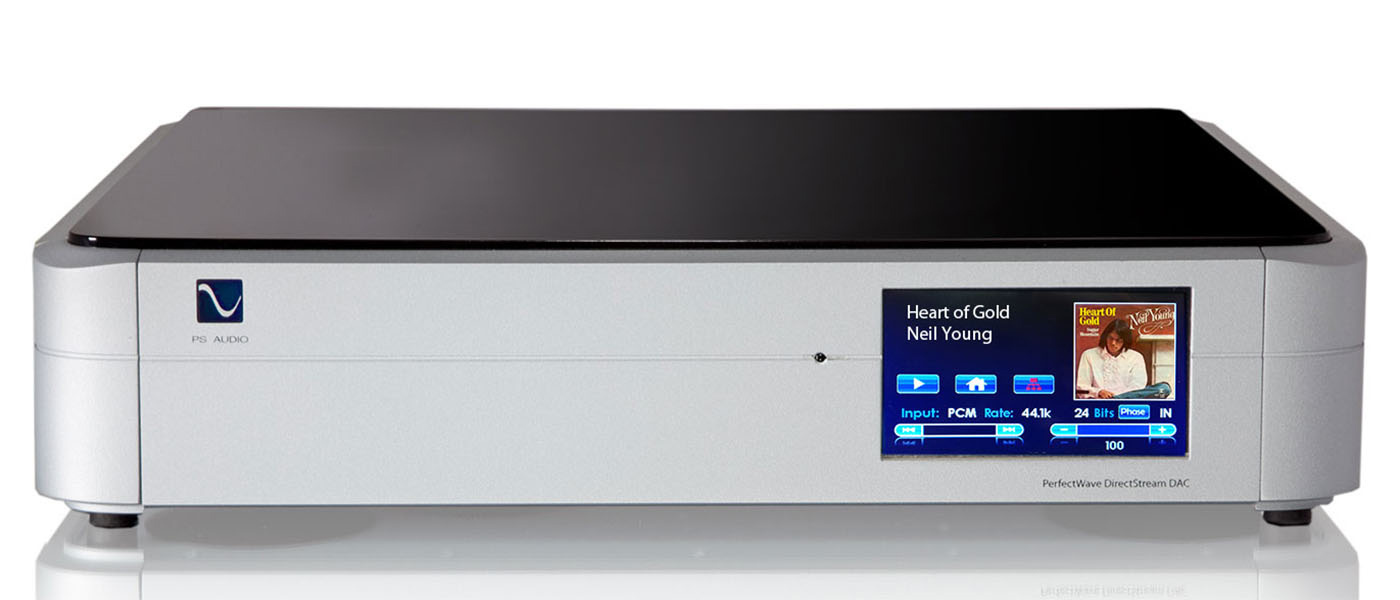It can decode just about any format, DSD included. It also uses a custom “DAC” implemented with a field-programmable gate array (FPGA) and custom firmware rather than using a commercial off the shelf DAC chip. This, plus the sound quality, are all pretty amazing for the $399 asking price. But the new thing here is the new $749 Poly streamer module designed to work with the Mojo DAC. The Poly can do just about anything. Stream music to it from your own DLNA, Airplay or Roon servers, play music wirelessly to it from your phone with DLNA or Airplay, and use it as a music player to play from the internal SD card either directly using MPD, or serve that music up to other DLNA capable devices on the network.
The Chord Electronics Mojo DAC and Poly streamer combination is the best sounding, most feature-packed portable headphone amp/DAC/streamer I have had the pleasure to listen to. The Poly is a powerful but somewhat complicated device that requires its user to have the willingness and ability to deal with its setup and use. It’s not for everyone. But if you can deal with the setup required, the Poly really does offer some attractive capabilities that make it capable of doing almost anything you could want from a streaming DAC both in portable use and at home or work.

Chord Electronics Mojo DAC and Poly Streamer
- Sound quality is second to none as far as portable DAC/amps go.
- The Poly streamer has almost every feature you could possibly want in a wirelessly connected music streamer/player.
- Once your phone or tablet is properly set up with the correct phone apps and network settings, the Poly works perfectly.
- Given the sound quality and feature set, the Mojo/Poly is a good value. Expensive for a portable system, but you get what you pay for.
- Excellent build quality. It looks and feels expensive.
- Flawless measurements.
- Long battery life.
The Chord Electronics (“Chord” for the rest of the review) Mojo is one of the best-regarded portable DACs around right now. It can decode just about anything, DSD included. It also uses a custom “DAC” implemented with a field-programmable gate array and custom firmware rather than using a commercial off the shelf DAC chip. This, plus the sound quality, are all pretty amazing for the $399 asking price. But the new thing here is the new $749 Poly streamer module designed to work with the Mojo DAC. Normally, you’d use an Apple camera connection kit with an iPhone, or a USB OTG cable with an Android phone to plug directly into the Mojo and play music off your phone the old fashioned way. The Poly allows much, much more than this. The Poly is a module about ½ the size of the Mojo that plugs in the side. What’s inside is a fully functional computer running a DLNA server, an MPD server, a Roon endpoint and a micro SD card slot capable of hosting any size card. It even has Wi-Fi. It can join your network, or make its own hotspot for your phone to connect. You can do just about anything. Stream music to it from your own DLNA, Airplay or Roon servers, play music wirelessly to it from your phone with DLNA or Airplay, and use it as a music player to play from the internal SD card either directly using MPD, or serve that music up to other DLNA capable devices on the network.
Chord Electronics Mojo DAC
Output Impedance:
75mOhms
Dynamic Range:
125dB
THD @ 3v:
0.00017%
Playback time:
Approx. 8 hours
Charging time:
Approx. 4 hours
Charging input:
5V / 2A micro USB
Inputs:
1x Micro USB 768kHz/32-bit Capable Input
1x 3.5mm Jack Coaxial 768kHz/32-bit Capable Input
1x Optical TOSLINK 96kHz/24-bit Capable Input
1x 1 amp Micro USB Charging Port Input
Output:
2x 3.5mm Headphone Jacks
Weight:
180g (6.3 oz.)
Dimensions:
82mm (l) x 60mm (w) x 22mm (h) / 3.23” (l) x 2.36” (h) x 0.87” (h)
MSRP:
$399
Chord Electronics Poly Streamer
Dimensions:
50 x 62 x 22 mm / 1.97” x 2.44” x 0.87”
Weight:
91 g / 3.2 oz
Playback time:
Approx. 9 hours
Charging time:
Approx. 5 hours
Charging input:
5V / 2A Micro USB
Battery:
LiPo 2200mAh
Wi-Fi:
2.4 GHz, hotspot mode supported
Playback support:
Roon, DNLA (server and renderer), MPD, AirPlay and Bluetooth 4.1
File types:
ACC, WAV, FLAC, AIFF, OGG VORBIS, ALAC, WMA, and MP3
Bluetooth:
4.1 / A2DP
PCM sample rates:
44.1 kHz – 768 kHz
DSD via DoP:
DSD64 – DSD256
Storage:
MicroSD (unlimited capacity)
Outputs:
USB to Mojo only
Devices supported:
iPhone, iPad, Android phones/tablets, Windows and Mac OS X computers and DAPs
MSRP:
$749
Company:
Company Directory:
SECRETS Tags:
Chord Electronics, DAC, streaming, digital audio player, portable, headphones, DAC Reviews 2019
This review really covers two separate products, designed to be used together. The Chord Mojo DAC has been around for a while and has gathered quite a cult following especially for people into portable music and headphones. I’ll spend a little less time on it because there are plenty of reviews out there, but there are a few details that deserve attention.
The key to the Mojo is the implementation of the DAC. Most every DAC you’ll find uses a commercial DAC chip bought from a supplier. This could be either a delta-sigma DAC that internally uses an oversampled 1-bit architecture to deliver its analog output (most DACs) or a ladder DAC architecture that internally processes with the full number of bits (like the Schiit Multibit DACs).
Secrets Sponsor
Chord does something completely different. They implement the digital part of the DAC in an FPGA (stands for Field Programmable Gate Array). An FPGA is a chip consisting of lots and lots of digital gates that can be reconfigured to do a particular task. The designer develops a “firmware”, then uploads it to the FPGA. This process physically reconfigures the digital logic inside the chip, which then performs the particular task the firmware was designed to accomplish. It’s partway between a purpose-built ASIC (Application Specific Integrated Circuit) chip that can only do one thing, but do it fast and with low power, or a processor or microcontroller that can do a limited number of operations but can do any task when it runs software designed for that task. Processors or microcontrollers are too slow to implement a DAC unless you use a very big, complicated one. A small FPGA is just right.
We use FPGAs all the time in my day job as a radio astronomer for implementing custom signal processing. We have very specialized needs, and making a custom ASIC is very expensive. FPGAs allow us to do what we need at a reasonable cost. Chord does the same. They can implement a fully custom DAC that does exactly what they want in every detail but at a cost far lower than what a custom DAC chip would cost them. They are justifiably tight-lipped on exactly what DAC algorithms they implement on the FPGA. Developing firmware is a lot of work, and I’m sure they’d rather not give away the secret sauce.
The FPGA does all the digital operations, which is then combined with a custom analog output stage to provide the output. This custom DAC can decode both PCM and DSD (with DoP files) at most every sample rate you could imagine. The highest bit rates (PCM 768 kHz and DSD 256) are supported by USB only, but there are also coax and Toslink digital inputs. The USB input is compatible with both computers and phones, although an iPhone will require the Apple camera connection kit.
The Mojo also uses very high-performance Lithium Polymer (LiPo) batteries to get the maximum battery life out of the high-performance electronics. FPGAs do consume more power than ASICs, and of course, the Mojo has a stout dual output headphone amplifier. When the batteries finally do degrade as all rechargeable batteries do, you can send the Mojo (and Poly) back to Chord for a battery replacement.
The Mojo uses colored LED buttons to provide information on the sample rate and volume setting. Chord really does like their colored lights. I found them a bit confusing. The information is there, but I always had to refer to the manual to know what all the colors meant.
The Mojo also has two USB sockets. One is just for charging and one is for the signal. Mix them up and the Mojo won’t charge or won’t play. You won’t hurt anything, but you may fail to charge the thing when you thought you were. Ask me how I know.
The case is made of machined aluminum and the colored buttons are custom frosted plastic spheres that push micro switches inside the case. The styling can take some getting used to but it does look and feel high end, with no cheap stuff anywhere. Quite amazing for the price point, both inside and out.

The Poly is a new device designed to complement the Mojo. On its own, the Poly is not useful. It needs to be connected to a Mojo to be able to power on and operate. It turns the Mojo into a Swiss army knife streaming DAC that can do just about anything. The Poly itself is actually a tiny Linux computer with its own LiPo battery in a small case that plugs into the Mojo. It has a pass-through USB port for charging both the Mojo and the Poly at the same time (although they will charge faster if you use two chargers and two cables). The Poly will not pass through a USB audio signal. The jack is for charging only. All playback is done through streaming or the SD card. It has a small button used to configure the Poly if for some reason the preferred phone method doesn’t work, and a micro SD slot.
So what can the Poly do? A lot. It can work as a DLNA renderer or Roon Endpoint playing music over Wi-Fi from your server located elsewhere on the network. If you load up a micro SD card with music, it can play that using an MPD (Music Player Daemon) app for control, or send it out to other devices using its DLNA server. It can also play music over Airplay for Apple devices from your phone, or in a pinch play music over Bluetooth, although that is definitely not the way to go since Bluetooth audio is compressed. It, unfortunately, has no good way to play music located on an Android device. Bluetooth is the only option for that.
The initial setup is handled with the Chord GoFigure app over Bluetooth. From that app, you configure the Poly to connect to your local Wi-Fi network or act as its own Wi-Fi hotspot the phone can connect to. Since I used the Poly primarily as a portable device, I set up the Wi-Fi hotspot. With some more iPhone configuration tricks, I was able to get the phone to use the cellular internet connection at the same time as the Wi-Fi connection to the Poly for music. Chord provides directions for this, but it’s not something that happens by default. You normally lose internet connection when you connect to the Poly hotspot. For portable operation, I loaded up my entire music library in Apple Lossless, FLAC and DSD DoP on a 400 GB micro SD card. I used the MPD app Rigelian to control the Poly.
At home, I used the DLNA app 8player with my phone on my local Wi-Fi network to stream from my network-attached storage drive running a DLNA server. Other than the apps used, these performed identically. Any MPD or DLNA app will work. There are many available and most cost a few dollars for the full-featured versions. I did not test the Roon endpoint functionality since I don’t use Roon. I also never used the Mojo alone fed by a computer since this review is about the Poly/Mojo combination.
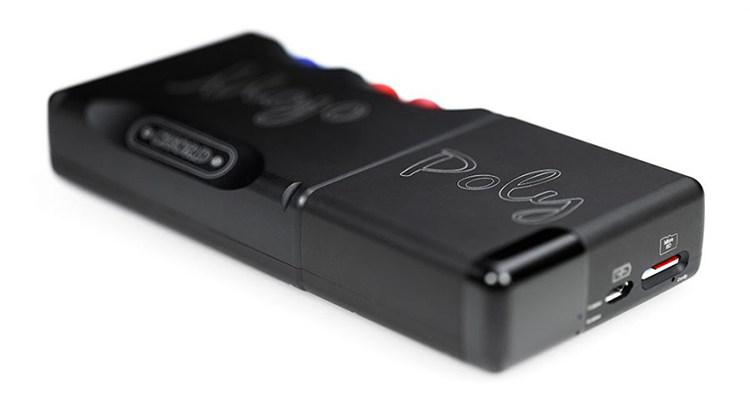
This description reveals the major drawback (for some at least) of the Poly. It is very complicated. It can do a lot, but it needs multiple third party software apps to run. Chord’s GoFigure app is used just to configure the device over Bluetooth and change that configuration (like switching between Wi-Fi hotspot mode and normal Wi-Fi mode).
To actually use the Poly, you need other third party software to control the DLNA streaming, Roon streaming or MPD player. Chord recommends apps for these functions but does not support the user in setting them up, troubleshooting them or using them. If you have a really good dealer, they could in principle set all this up for you and teach you how to use it.
I am a tech person, so I did it all myself and thought it was kind of fun to figure it all out and troubleshoot issues. If you’re a Luddite or even a person for whom that sort of tech adventure sounds less than fun, maybe the Poly isn’t for you. As apps and their features change, you’ll need to adapt. The only thing that worked without any third party setup was Airplay streaming from the Apple music player on the phone. If the Poly is on the network (either hotspot or normal), Airplay just works. MPD using Rigelian was also straightforward unless the app decides it needs you to renew the purchase of the full version without the internet being available. This happened once to me on a plane and I had to make do with the limitations of the free version of Rigelian until I got to my destination. And with any complicated system, stuff breaks. The Poly relies on a Wi-Fi connection working and properly set up. This is your problem and requires some knowledge of Wi-Fi setup to get right. I could not imagine someone like, say, my father having any hope of successfully using the Poly. I thought it was great, though.
Once it was all set up correctly and I understood how it functioned, it worked flawlessly for me. I think it would help a lot if Chord’s own app was a one-stop-shop for controlling MPD and DLNA. I’m sure Chord thinks of this as re-inventing the wheel since all those things can be done with existing apps. But it would be a lot simpler for non-techies to use and love the Poly if a single well-designed app could control all the functionality of the Poly in a simple way. But that would be very expensive and probably force Chord to raise the price of the Poly past the current $749. This is already significantly more than the Mojo itself. But if you want simple, maybe the best idea is to just plug the Mojo into your phone with a cable and play music the “old fashioned’ way.
I listened to my Mojo/Poly mainly in Wi-Fi hotspot mode using the MPD with the Rigelian app playing music off the local SD card. The sound was identical in DLNA mode assuming the Wi-Fi connection to the DLNA server was good. I tried Airplay which also worked fine, at least given the limitations of Airplay (no more than 16 bit 48 kHz file support). I listened to Apple lossless 16-bit 48 kHz files, 24-bit 88.2 kHz, 96 kHz, 176.4 kHz and 192 kHz PCM files in both Apple lossless and FLAC formats, and DSD64 files in DSD DoP format I ripped from my own SACD disks using the Oppo BDP-105 method. The Poly played everything without any issue.
I mostly used my HiFiMan RE-800 IEM headphones, but every once in a while used Sennheiser HD-600s. I also gave the Mojo/Poly a try with my home system using an Audioquest mini to RCA adapter. The setup works just fine for a home system, but the Mojo/Poly runs only from batteries. Connecting the pair to a USB power source only charges the batteries and is not recommended to be connected during use.
One note on charging. When the pair is almost fully charged, the Mojo will emit a funny squealing noise. Chord says this sound is normal and comes from the inductors in the charging circuit. It is alarming and annoying but only lasts a few minutes as the Mojo comes up to full charge.
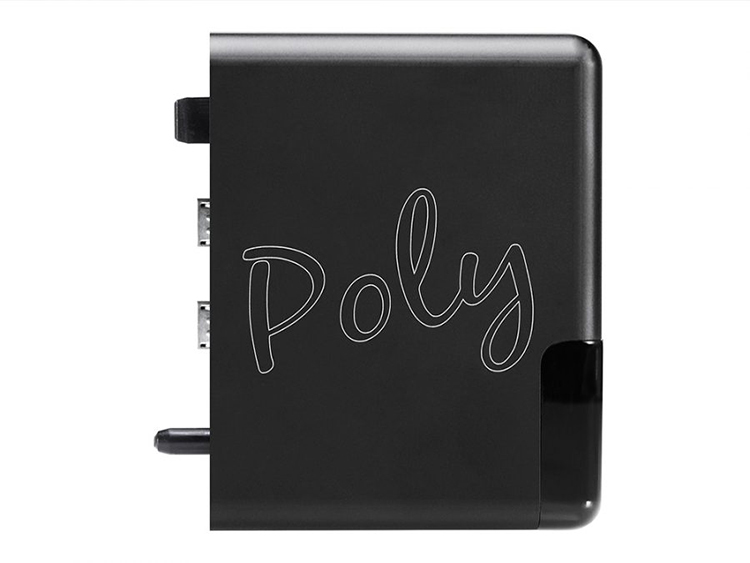
Listening to the Mojo/Poly was a revelation. I thought my normal Oppo HA-2 was good, and it is good. But the Mojo is great. The Chord pair matches or exceeds the best sound I’ve heard from my headphones driven by desktop equipment. Since this review is first and foremost about the Poly, I can report that the sound quality from the Mojo/Poly combination is identical to that of the Mojo on its own driven by USB or coax inputs.
I tried this experiment at my desk driving the Mojo with my desktop computer. The Mojo compared favorably to my Schiit Asgard 2/Bifrost Uber rig. It’s fully class A and costs more than double the price of the Mojo. And the Mojo decodes more formats. In direct comparison, I found the Mojo better at extracting detail and presenting a smooth, open sound. The Schiit combo had the edge on impact, power, and control, as you’d expect from a big, class-A solid-state amp. I’d be hard-pressed to pick one over the other though, and the Mojo/Poly is portable.
Compared to the HA-2 in portable listing, there was no comparison. The Mojo extracted more detail while sounding more open and more three dimensional. There was less glare and hardness to the sound across the board, especially with 16 bit 44.1 kHz files and DSD files. Everything sounded better, in every possible way I could think about it. The bass quality was truly amazing for a portable player. The RE-800s sounded every bit as good listening portably as they did at the desk driven by the Asgard 2. But I think the quality of the Mojo/Poly I valued most was the size and three-dimensionality of the soundstage. The size and openness of the presentation made the soundstage seem about twice as big as the HA-2.
The ease of the sound made long listening stints on airplanes or at my desk effortless, with no hint of glare or harshness. The only drawbacks came in the convenience of use issues. Most of the time things worked fine. But I fought a pretty much constant battle of my phone joining the wrong Wi-Fi network (my work network instead of the Poly). Sometimes the phone would decide to connect to the wrong network as I was listening. With MPD, you only need to talk over the network to issue commands. So sometimes I would listen for a long time without interaction and my phone would decide to connect to a different network when I unlocked it. Pretty much every time, the MPD app would have to “wake up” and connect with the Wi-Fi and then MPD server if the phone had been locked, taking several seconds to kick in assuming everything went as planned. Sometimes I had to quit apps and restart them, turn the Wi-Fi off then on again, etc. to get the MPD app to see and control the Poly.
DLNA seemed to work a little more reliably at home because there was no confusion as to what network to join, and the network connection was in constant use while playing. In any case, the interface is definitely not foolproof, and will almost certainly require care and feeding to keep working. The sound quality and features are definitely unmatched for a portable player, though.
I decided to measure the Mojo/Poly combo in a way that was as close to actual use as I could. Usually, I would generate SPDIF digital signals with my M-Audio Profire 610 sound interface and SpectraPlus FFT software directly and measure the analog output with the same interface and software. Instead, I generated 24 bit 192 kHz test tone WAV files with SpectraPlus, then converted these to FLAC files with Max 0.8. I put these files on the Poly’s SD card and played them back over MPD using Rigelian.
Since the Mojo has dual headphone outputs, I plugged in my HiFiMan RE-800s into one output and an Audioquest 3.5mm to RCA adapter into the other connected to the Profire 610. I set the volume control of the Mojo in the middle of its range for testing. This is far louder than I would want to listen. For the most part, I ended up measuring the Profire 610. The measured results are similar to a loopback test, so they should be interpreted as upper limits. The SpectraPlus FFT software and Profire 610 were set up in 24 bit 192 kHz mode with an audio bandwidth of 96 kHz.

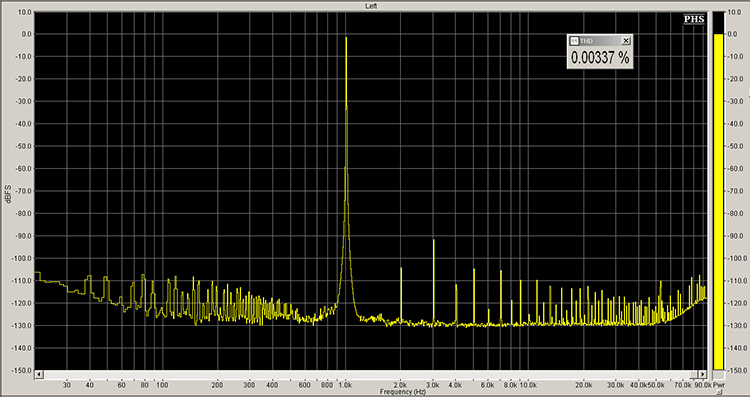
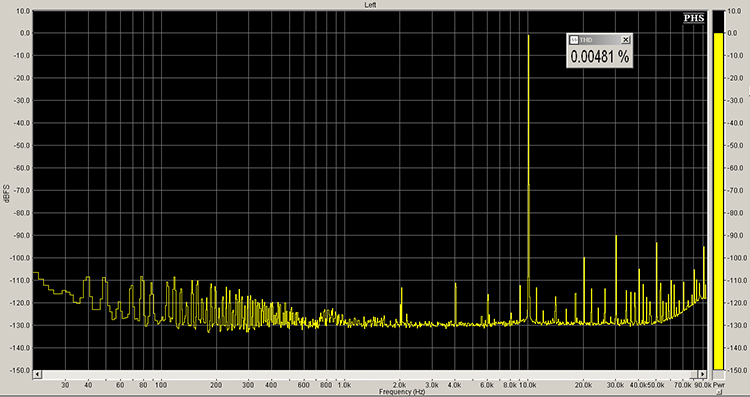
Total harmonic distortion was measured with 60 Hz, 1 kHz and 10 kHz -5 dBFS test tones. THD was extremely low, at between 0.003% and 0.004%, with the highest harmonic (third) at -90 dB below the fundamental. The distortion spectrum is typical of a push-pull solid-state amplifier, but of course at very low distortion levels. Note this is the lowest distortion of any headphone amp I have measured, and similar to the best DACs with my measurement gear. Just to check, I measured no difference in distortion with or without the headphones plugged in.
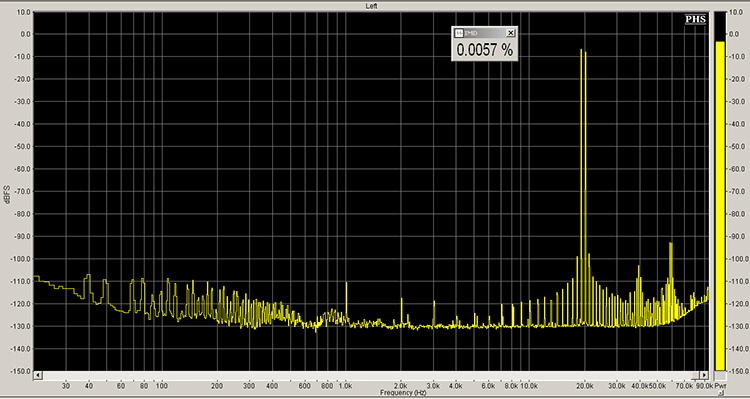
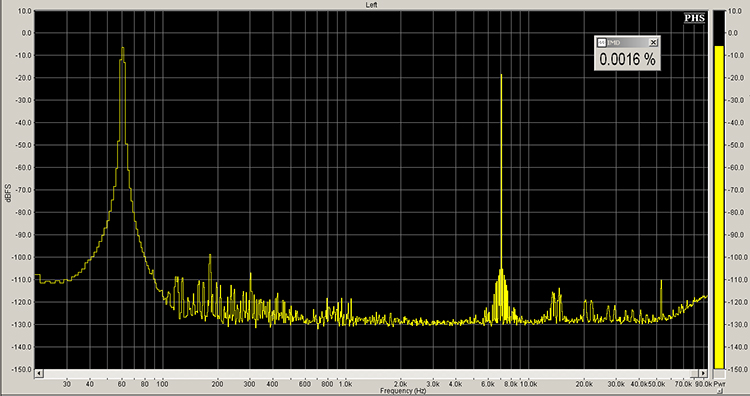
Inter-modulation distortion was measured with both 19 kHz + 20 kHz tones and 7 kHz + 60 Hz tones again at –5 dBFS. IMD with the higher frequency tones was just under 0.006% with the 1 kHz B-A peak over 100 dB down from the fundamentals. The 7 kHz + 60 Hz measurement was 0.0016%, with the sidebands around the 7 kHz tone about 90 dB down from the peak. These are also first-rate numbers.
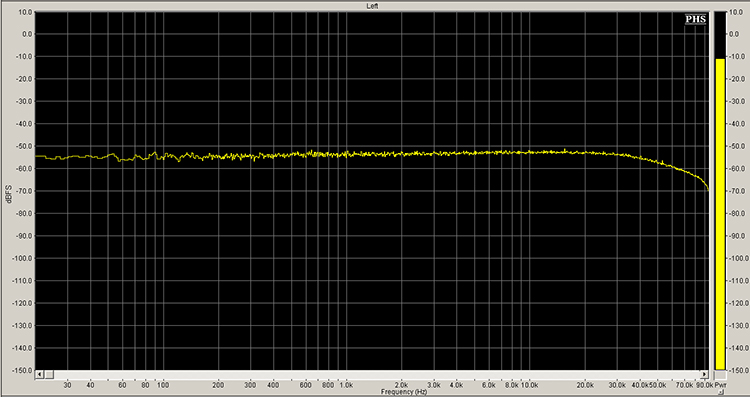
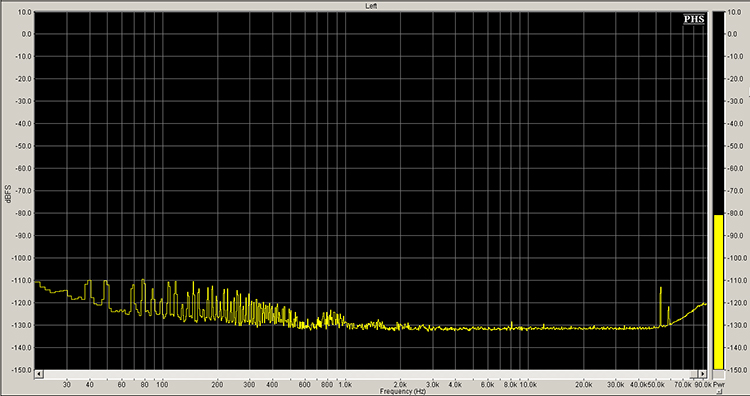
The frequency response was flat as a pancake to 20 kHz, then began a gentle roll-off from the slow roll anti-aliasing filter. The small rise in frequency response is due to the Profire 610, not the device under test. In addition, I made a “Digital silence” file to measure the noise floor. What you see is basically the noise floor of the Profire 610. The two small peaks above 50 kHz are artifacts. The low frequency “noise” is 60 Hz pickup from the headphone wires acting as an antenna. They go away when the headphones are unplugged.
Secrets Sponsor
In summary, these measurements are flawless, and at the limit of my ability to measure them given my test equipment.
The CHORD ELECTRONICS MOJO is definitely a steal at $399. It is one of the best if not the best sounding portable DAC/Amps I have ever heard. The $749 Poly is a bit pricier, but there’s no other product like it. It turns the Mojo into the most full-featured wireless streaming DAC I know of. The price is a considerable amount of technical complexity the user has to accept and live with.
- Sound quality second to none for portable devices.
- Decodes virtually every format and sample rate there is.
- Streamer has just about every feature anyone could want.
- Works well once properly set up.
- It looks and feels expensive.
- Flawless measurements.
- Improved instructions for setup of both the Poly and the network settings and third-party apps needed to use it.
- An integrated app that can operate all of the Poly’s functions from one place in a unified and intuitive way.
- A high-quality way to stream music from an Android phone’s internal storage to the Poly. Bluetooth doesn’t cut it.
The Chord Electronics Mojo/Poly combination is the best sounding, most feature-packed portable headphone amp/DAC/streamer I have had the pleasure to listen to. But the Poly is a powerful, complicated beast that requires its user to have the willingness and ability to deal with its setup and use. It’s not for everyone.
So the question you have to ask yourself is “Am I willing and able to put up with the technical challenges to get the sound quality and features?” If the answer is no, maybe a Mojo connected to your phone over USB is a better choice. That will work like any other portable DAC/amp. But if you are a person who can accept the care and feeding of the Wi-Fi connection and third-party apps, the Poly really does offer some attractive capabilities that make it capable of doing almost anything you could want from a streaming DAC both in portable use and at home or work.


